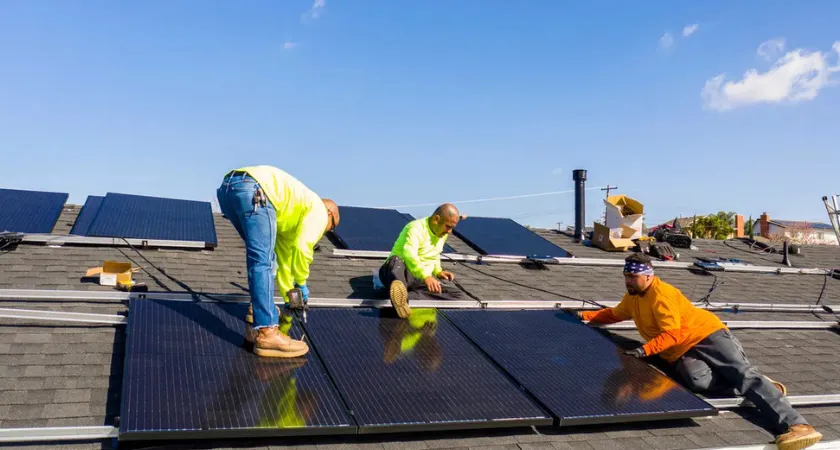
The U.S. Department of the Treasury has released new guidance that reshapes how wind and solar developers must prove they’ve started construction to secure lucrative federal tax credits.
Until now, most renewable energy projects relied on the so-called 5% safe harbor test, which allowed developers to qualify for credits if they could demonstrate that at least 5% of a project’s total cost had been incurred. But the latest rules, issued late Friday, shift the focus from spending to physical activity.
.jpeg)
Under the new framework, construction will be considered to have begun “when physical work of a significant nature begins,” whether that work takes place on-site or off-site. The Treasury emphasized that, unlike the old 5% rule, there is no minimum spending or set percentage requirement attached to this updated Physical Work Test.
“This test focuses on the nature of the work performed, not the amount or the cost,” the guidance states. “Provided that physical work performed is of a significant nature, there is no fixed minimum amount of work or monetary or percentage threshold required to satisfy the Physical Work Test.”
A limited exception remains in place for smaller projects: solar facilities under 1.5 MW of net output can still use the 5% cost test.
The changes stem from the One Big Beautiful Bill Act (OBBBA), which gradually phases out the 45Y production and 48E investment tax credits for wind and solar facilities placed in service after 2027. However, projects that begin construction before July 5, 2026—a year after the bill’s signing—remain eligible. The new guidance clarifies that the Physical Work Test will be the sole method (with the small solar carve-out) for establishing that construction has begun.
The treatment of renewable tax credits was among the most contentious elements of the OBBBA’s passage. Some Senate Republicans pushed for a more gradual phaseout, while others supported stricter measures. In the end, the Biden administration faced pressure from lawmakers who conditioned their support on tighter Treasury rules for renewables.
Following the guidance’s release, Sen. Chuck Grassley, R-Iowa, one of the most vocal negotiators on the issue, expressed approval:
“Renewables are an essential part of the ‘all of the above’ energy equation. I’ll continue speaking with industry leaders to ensure those in Iowa and nationwide are afforded a smooth off-ramp, as Congress intended.”
But clean energy advocates voiced strong concerns. Abigail Ross Hopper, president and CEO of the Solar Energy Industries Association, said the administration had made an “unprecedented side deal” with opponents of clean energy that could harm the sector.
“This will hurt the solar industry and raise electricity prices,” Hopper warned.
.jpeg)
Legal experts offered a more cautious interpretation. Attorneys at Norton Rose Fulbright noted the guidance was “not as bad as rumored,” but flagged lingering uncertainty.
“The financiers will have to decide where they feel comfortable drawing lines,” they wrote. “Many developers relied on physical work in the past to start construction, and the market was able to function … The new construction-start rules apply to wind and solar projects on which construction starts on or after September 2, giving developers a short window to tidy up any construction-start efforts they have currently underway.”
Similarly, law firm McGuireWoods framed the guidance as a relief compared to expectations under President Trump’s July 7 executive order, which had called for “strict enforcement” of the construction-start standard.
“It appears the Treasury has given deference to the historical and plain meaning of the term beginning of construction,” the firm wrote. “The physical work test in the Notice appears to be identical to the test in the Pre-[Inflation Reduction Act] Notices.”
Still, some clean energy advocates worry the changes amount to a backdoor weakening of renewables policy.
Jeff Cramer, CEO of the Coalition for Community Solar Access, criticized the Treasury’s approach:
“By narrowing the rules for what qualifies as having started construction, the administration has upended long-standing, bipartisan standards in a way never agreed to during the legislative process.”
Heather O’Neill, president and CEO of Advanced Energy United, also raised concerns:
“These rules create new federal red tape. They eliminate long-standing precedent for how companies demonstrate they’ve begun project development.”
The updated rules create a narrower pathway for wind and solar developers seeking to qualify for federal credits. While large-scale projects may adapt by shifting documentation toward construction activity, financing could become more complex. Investors may require stricter assurances that physical work meets the Treasury’s undefined “significant” threshold.
At the same time, the ruling appears to avoid the harshest possible outcome—one in which developers would need to complete a substantial portion of their facilities before being deemed eligible for tax credits.
For now, industry lawyers, financiers, and developers are racing to adjust strategies ahead of the September 2 effective date, which marks the cutoff for projects already underway under the old standard.
The decision could shape the trajectory of renewable energy development over the next two years, as projects scramble to begin construction by the July 2026 deadline before credits phase out entirely.
Originally reported by Diana DiGangi in Utility Dive.